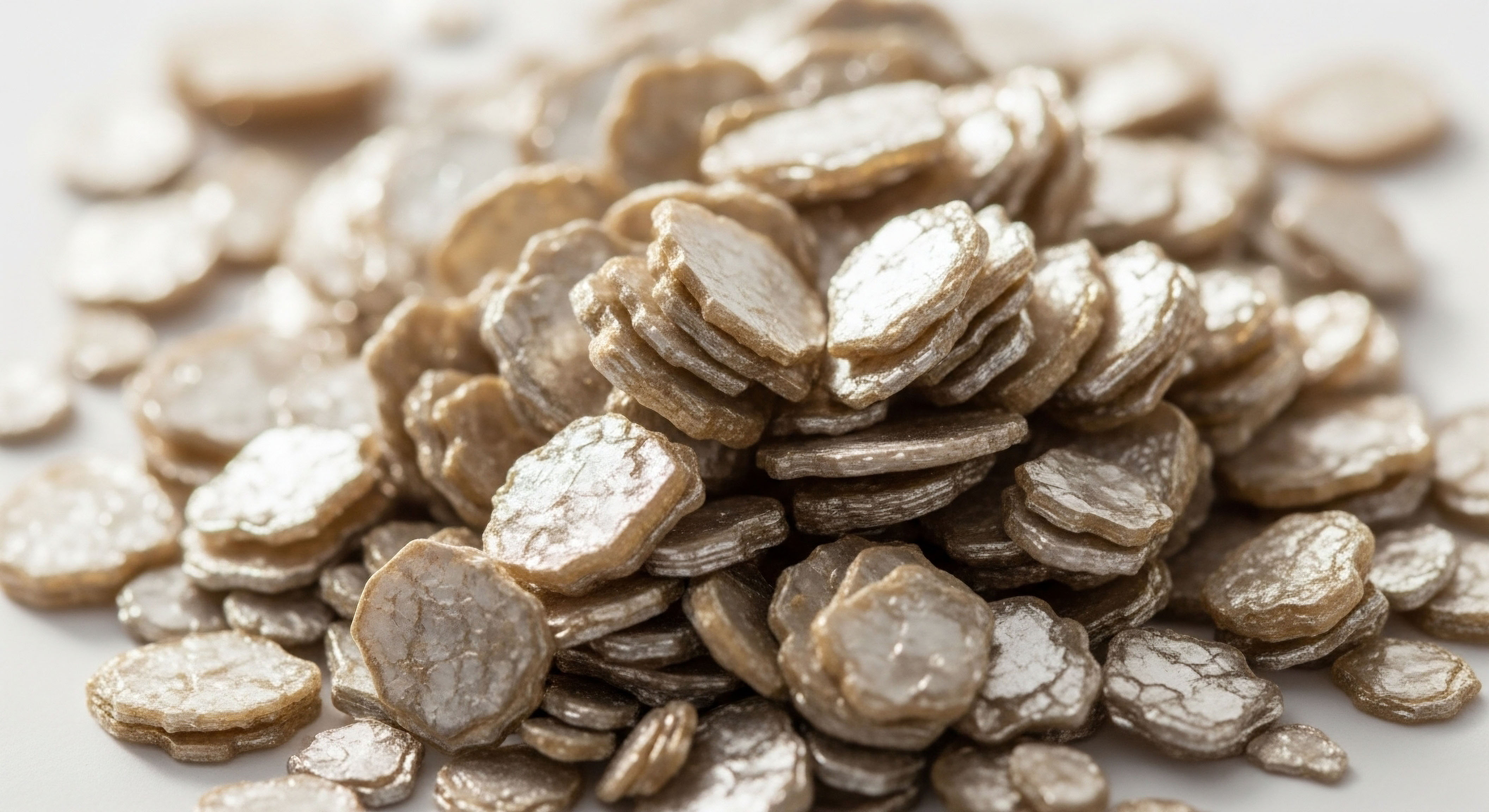

Fundamentals
You feel the shift. A subtle, persistent decline in energy, a change in your body’s composition that diet and exercise alone no longer seem to touch, a fog that clouds mental clarity. These experiences are valid, rooted in the intricate and powerful language of your body’s endocrine system.
When we introduce hormonal protocols, such as Testosterone Replacement Therapy (TRT) or peptide therapies, we are providing the body with a specific set of molecular instructions. The question that naturally follows is a critical one ∞ Does the life you lead, the food you consume, and the way you move your body alter how well these instructions are received and utilized?
The answer is an unequivocal yes. Your lifestyle choices are the environment in which these hormonal signals operate. A precisely calibrated hormonal protocol is the key, and the body’s internal environment determines how well that key turns the lock. Diet and exercise are the foundational elements that prepare the body to respond optimally to these therapies, influencing everything from cellular sensitivity to metabolic efficiency.

The Body as a Responsive System
Your body is a dynamic system, constantly adapting to internal and external signals. Hormonal therapies introduce a powerful new signal, but its effectiveness is shaped by the existing biological landscape. Consider the role of body composition. Excess body fat, particularly visceral fat around the organs, is metabolically active and can disrupt hormonal balance.
This adipose tissue produces enzymes and inflammatory markers that can interfere with how your body uses testosterone. By adopting a nutritional plan that promotes a healthy body composition, you are essentially clearing the lines of communication, allowing the therapeutic hormones to exert their effects more efficiently.
Similarly, regular physical activity does more than burn calories; it enhances insulin sensitivity, reduces inflammation, and improves circulation. Each of these factors contributes to a more receptive hormonal environment, ensuring that the administered protocols can achieve their intended purpose without unnecessary interference.

Nutrition the Building Blocks of Hormonal Health
The food you consume provides the raw materials your body needs to function, and this is especially true when undergoing hormonal optimization. A diet rich in specific nutrients can directly support the efficacy of treatments like TRT. For instance, adequate protein intake is essential for muscle protein synthesis, a process that is significantly enhanced by testosterone.
Healthy fats are the precursors to many hormones, and their presence in the diet supports the body’s natural endocrine pathways. Certain micronutrients also play a vital role. Zinc and magnesium are cofactors in the production of testosterone, while Vitamin D functions as a prohormone, influencing numerous aspects of endocrine health.
A well-structured nutritional plan provides the necessary components for the body to not only receive the benefits of hormonal therapy but to amplify them, leading to improved muscle mass, reduced fat, and greater overall vitality.
Lifestyle choices create the biological context that determines the success of any hormonal intervention.

Exercise as a Potentiator of Hormonal Effects
Physical activity, particularly resistance training and high-intensity interval training (HIIT), acts as a powerful catalyst for hormonal therapies. When you engage in strenuous exercise, you create a physiological demand that testosterone is uniquely equipped to meet.
This demand signals the body to increase the number and sensitivity of androgen receptors in muscle tissue, effectively making your cells more receptive to the testosterone introduced through TRT. The result is a synergistic effect where the therapy provides the hormonal potential, and the exercise provides the stimulus to realize that potential in the form of increased strength and lean muscle mass.
Exercise also improves metabolic health, which is closely linked to hormonal function. By enhancing insulin sensitivity and reducing inflammation, physical activity creates a more favorable environment for all hormones to function optimally, from testosterone to growth hormone peptides. This synergy means that the outcomes of a well-designed hormonal protocol are significantly magnified when paired with a consistent and appropriate exercise regimen.


Intermediate
Advancing beyond the foundational understanding that diet and exercise are beneficial, we can examine the precise mechanisms through which these lifestyle factors modulate the efficacy of specific hormonal protocols. For an individual on a regimen of Testosterone Cypionate, Gonadorelin, and Anastrozole, or a woman utilizing low-dose testosterone with progesterone, lifestyle choices are not merely supportive; they are integral components of the therapy itself.
These interventions are designed to restore a complex physiological balance, and their success is contingent on a body that is primed to respond. Nutrition and physical activity directly influence the pharmacodynamics of these treatments, affecting everything from receptor density to metabolic clearance and the management of potential side effects. A strategic approach to diet and exercise can transform a standard protocol into a highly personalized and effective therapeutic experience.

How Does Lifestyle Influence Specific Hormonal Pathways?
The interplay between lifestyle and hormonal therapy is a multifaceted process that involves several key physiological pathways. For men on TRT, for example, the goal is to optimize testosterone levels while managing the potential for aromatization ∞ the conversion of testosterone to estrogen.
Anastrozole is included in many protocols to inhibit this process, but lifestyle factors can provide significant support. Body fat is a primary site of aromatase activity, the enzyme responsible for this conversion. A nutritional plan that promotes a lean body composition can therefore reduce the overall aromatase burden, potentially allowing for a lower effective dose of Anastrozole and minimizing side effects.
Exercise, particularly resistance training, has been shown to increase androgen receptor density in skeletal muscle. This means that for a given level of circulating testosterone, the body becomes more efficient at utilizing it for anabolic processes like muscle growth and repair. This enhanced sensitivity is a direct result of the physical stimulus provided by exercise, making it a critical factor in maximizing the benefits of TRT.

Optimizing Protocols through Diet and Exercise
A well-designed lifestyle plan can be tailored to support the specific goals of different hormonal therapies. For individuals using growth hormone peptides like Sermorelin or Ipamorelin, which stimulate the body’s own production of growth hormone, nutrition and exercise play a crucial role in maximizing the therapeutic window.
Growth hormone release is influenced by blood glucose levels, with high levels of insulin tending to suppress its secretion. A diet that emphasizes complex carbohydrates and manages glycemic load can help create a more favorable environment for these peptides to exert their effects.
High-intensity exercise is also a potent natural stimulus for growth hormone release, and timing peptide administration around workouts can create a powerful synergistic effect. For women on low-dose testosterone, the goals often include improved energy, mood, and libido.
A diet rich in phytoestrogens and fiber can help modulate the hormonal environment, while strength training can provide the stimulus needed to see tangible benefits in bone density and muscle tone. The table below outlines how specific lifestyle interventions can support different hormonal protocols.
| Hormonal Protocol | Supportive Dietary Strategy | Recommended Exercise Modality | Primary Mechanism of Synergy |
|---|---|---|---|
| Male TRT (Testosterone, Gonadorelin, Anastrozole) | High-protein, nutrient-dense diet with healthy fats. Focus on zinc, magnesium, and vitamin D. | Resistance training (e.g. squats, deadlifts) and HIIT. | Increased androgen receptor density, reduced aromatization, improved insulin sensitivity. |
| Female Hormone Therapy (Testosterone, Progesterone) | Balanced diet with adequate iron and calcium. Phytoestrogens from sources like flaxseed may be beneficial. | Strength training for bone density and muscle tone. Yoga or other stress-reducing activities. | Improved receptor sensitivity, enhanced mood and energy, better sleep quality. |
| Growth Hormone Peptide Therapy (Sermorelin, Ipamorelin) | Diet with controlled glycemic load. Avoid large meals, especially high-carbohydrate ones, around injection times. | High-intensity interval training (HIIT) and resistance exercise. | Enhanced natural GH pulsatility, improved insulin sensitivity, synergistic effect on muscle growth and fat loss. |
Strategic lifestyle modifications can enhance the therapeutic effects of hormonal protocols by directly influencing their physiological pathways.

Managing Side Effects and Long Term Health
An often-overlooked aspect of lifestyle’s role in hormonal therapy is its impact on managing potential side effects and promoting long-term health. For instance, TRT can influence cardiovascular markers, and a diet rich in omega-3 fatty acids, fiber, and antioxidants can support cardiovascular health.
Regular aerobic exercise is also essential for maintaining a healthy heart and blood vessels. Similarly, for individuals on protocols that include medications like Anastrozole, which can affect bone density, weight-bearing exercise is a critical component of a comprehensive treatment plan.
By proactively addressing these potential issues through diet and exercise, individuals can not only enhance the positive effects of their hormonal therapy but also mitigate potential risks, ensuring that their journey towards optimization is both effective and sustainable. This integrated approach underscores the principle that hormonal health cannot be achieved in a vacuum; it is the result of a carefully orchestrated interplay between targeted therapies and a supportive lifestyle.


Academic
A sophisticated analysis of the interaction between lifestyle factors and hormonal therapies requires a deep dive into the molecular and physiological mechanisms that govern these processes. From a systems-biology perspective, the introduction of exogenous hormones or secretagogues is a significant perturbation to a complex, interconnected network.
The efficacy of such an intervention is determined by the system’s ability to adapt and utilize the new signal. Diet and exercise function as powerful modulators of this adaptive response, influencing everything from gene transcription and receptor kinetics to metabolic flux and inflammatory signaling.
Examining these interactions at a granular level reveals a highly synergistic relationship, where lifestyle factors do not merely support hormonal protocols but are, in fact, indispensable for achieving optimal and durable outcomes. The research literature provides compelling evidence for this synergy, particularly in the context of TRT and peptide therapies, highlighting the intricate dance between pharmacology and physiology.

Molecular Mechanisms of Synergy
At the molecular level, the synergy between exercise and testosterone therapy is particularly well-documented. Resistance exercise initiates a cascade of intracellular signaling events, most notably through the activation of the mTOR pathway, which is a central regulator of muscle protein synthesis. Testosterone, acting through the androgen receptor, also potently stimulates this pathway.
The combination of these two stimuli results in a supra-additive effect on muscle hypertrophy. Studies have shown that exercise can increase the expression of androgen receptor mRNA and protein in skeletal muscle, effectively priming the tissue to respond more robustly to circulating testosterone.
This upregulation is a key mechanism through which exercise enhances the anabolic effects of TRT. Furthermore, diet plays a critical role in this process by providing the necessary substrates for these anabolic processes. Amino acids, particularly leucine, are not only the building blocks of new muscle tissue but also act as signaling molecules that can further stimulate the mTOR pathway.
Thus, a diet rich in high-quality protein, combined with resistance exercise, creates an optimal biochemical environment for testosterone to exert its effects.

The Role of Insulin Sensitivity and Inflammation
Insulin resistance and chronic low-grade inflammation are two key pathological states that can significantly impair the efficacy of hormonal therapies. Both conditions are heavily influenced by diet and exercise. Insulin resistance, often a consequence of a sedentary lifestyle and a diet high in processed carbohydrates, can disrupt the hypothalamic-pituitary-gonadal (HPG) axis, leading to lower endogenous testosterone production.
In the context of TRT, insulin resistance can blunt the therapy’s positive effects on body composition and metabolic health. Exercise, by increasing glucose uptake into muscle cells through both insulin-dependent and independent pathways, is a powerful tool for improving insulin sensitivity.
A diet that manages glycemic load and is rich in fiber and healthy fats can further support this process. Chronic inflammation, driven by factors like a diet high in omega-6 fatty acids and a lack of physical activity, can also interfere with hormonal signaling.
Inflammatory cytokines have been shown to suppress steroidogenesis and can contribute to a state of hormonal resistance. By adopting an anti-inflammatory diet and engaging in regular exercise, individuals can reduce this inflammatory burden, thereby enhancing the body’s responsivity to hormonal interventions.
| Parameter | Effect of Diet and Exercise | Impact on Hormonal Protocol Efficacy |
|---|---|---|
| Androgen Receptor Density | Increased with resistance training. | Enhances the anabolic effects of testosterone in muscle tissue. |
| Aromatase Activity | Reduced with lower body fat percentage (achieved through diet and exercise). | Decreases the conversion of testosterone to estrogen, potentially reducing the need for aromatase inhibitors. |
| Insulin Sensitivity | Improved with regular exercise and a diet that manages glycemic load. | Optimizes metabolic health and supports the function of the HPG axis. |
| Systemic Inflammation | Reduced with an anti-inflammatory diet and consistent physical activity. | Improves overall hormonal signaling and reduces the risk of hormonal resistance. |
| Growth Hormone Pulsatility | Enhanced by high-intensity exercise and a diet that avoids high insulin spikes. | Maximizes the effectiveness of growth hormone secretagogues like Sermorelin and Ipamorelin. |
The interplay between lifestyle and hormonal therapy is a clear example of physiological synergy, where the combined effect is greater than the sum of its parts.

Durability of Response and Post-Therapy Considerations
A critical question in the field of hormonal optimization is the durability of the therapeutic response, particularly after the cessation of treatment. Research has begun to explore this area, and the findings underscore the importance of lifestyle interventions. A pilot randomized controlled trial published in 2016 investigated the effects of combining exercise with TRT.
The study found that the combination group not only showed greater improvements in testosterone levels and symptoms of late-onset hypogonadism compared to TRT alone, but these improvements were also better maintained after the cessation of therapy in the group that continued to exercise.
This suggests that exercise can induce lasting physiological adaptations that help maintain the benefits achieved during therapy. These adaptations likely include sustained improvements in insulin sensitivity, body composition, and androgen receptor density. This has significant implications for clinical practice, suggesting that a structured exercise program should be considered an essential component of any TRT protocol, not only for maximizing on-treatment benefits but also for promoting a more durable response and potentially facilitating a smoother transition off therapy if desired.
- Male TRT Protocols For men undergoing Testosterone Replacement Therapy, often supplemented with Gonadorelin to maintain testicular function and Anastrozole to control estrogen levels, lifestyle integration is paramount. A diet focused on lean protein and healthy fats supports the anabolic potential of testosterone. Resistance training amplifies this effect by increasing androgen receptor density in muscle tissue, making the body more responsive to the therapy.
- Female Hormonal Protocols In women, hormonal protocols may involve low-dose testosterone for energy and libido, often balanced with progesterone. Here, lifestyle factors play a crucial role in both efficacy and well-being. Strength training is vital for preserving bone density, a key concern during perimenopause and post-menopause. Nutritional strategies focusing on calcium, vitamin D, and iron can address common deficiencies and support overall vitality.
- Growth Hormone Peptide Therapy Protocols using peptides like Sermorelin or Ipamorelin to stimulate the body’s own growth hormone release are highly sensitive to lifestyle inputs. High-intensity interval training (HIIT) is a potent natural stimulus for GH release, creating a synergistic effect when timed with peptide administration. Similarly, a diet that avoids high-glycemic foods around the time of injection can prevent insulin spikes that would otherwise blunt the GH response.

References
- Cho, Dae-Yeon, et al. “Exercise improves the effects of testosterone replacement therapy and the durability of response after cessation of treatment ∞ a pilot randomized controlled trial.” The World Journal of Men’s Health, vol. 35, no. 2, 2017, p. 97.
- Saad, Farid, et al. “Effects of testosterone on metabolic syndrome components.” Best Practice & Research Clinical Endocrinology & Metabolism, vol. 23, no. 3, 2009, pp. 325-43.
- Aversa, Antonio, et al. “The role of exercise and nutrition in the management of late-onset hypogonadism.” Journal of Men’s Health, vol. 7, no. 3, 2010, pp. 236-41.
- Traish, Abdulmaged M. “Testosterone and weight loss ∞ the evidence.” Current Opinion in Endocrinology, Diabetes and Obesity, vol. 21, no. 5, 2014, pp. 313-22.
- Kelly, Daniel M. and T. Hugh Jones. “Testosterone and obesity.” Obesity Reviews, vol. 16, no. 7, 2015, pp. 581-606.

Reflection
The information presented here provides a map of the intricate connections between your daily choices and your hormonal health. It details the biological mechanisms and clinical evidence, offering a clear rationale for an integrated approach to wellness. This knowledge is the first, most crucial step. The next is to turn that understanding inward.
How do these systems function within your own unique biology? What signals is your body sending, and how can you best support its journey toward balance and vitality? This path is a personal one, a process of recalibration that begins with informed action. The potential to reclaim your function and feel your best is not found in a single prescription, but in the thoughtful synergy of targeted therapy and a life lived with intention.



